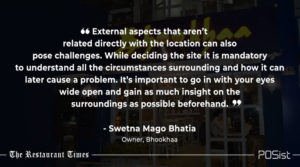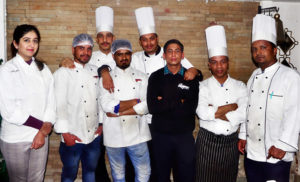Swetna Mago Bhatia is professionally a guest lecturer at Delhi University for German language, but her immense love for cooking shifted her focus to having a brand of her own. The first memory Swetna Mago Bhatia has of cooking is making pancakes when she was in the sixth grade. Inclination towards culinary art is something she’s had since the very beginning. Following her passion, she joined a culinary school, that further pushed her towards the food industry. Finally, along with her husband, she introduced her first brand Bhookhaa in 2012, that has received immense popularity since inception.
Bhookhaa is not only about great food, but the service. The food at Bhookhaa is served with love, warmth, and passion. The menu is designed to ensure that the customers would love to come back every day and the prices would surely not hinder them. Bhookhaa serves a little bit of everything, ranging from Continental, Lebanese, Indian Gravy, Indian Tandoor, and even street food. The aim is to take the consumers on a different journey through the experience they provide.
In Conversation With Swetna Mago Bhatia Of Bhookhaa
In an exclusive conversation with The Restaurant Times, Bhatia talks all about her brand Bhookha, daily operational challenges, expansion plans and a lot more.
Importance Of Location
Location is important. Depending on the kind of food you decide to serve and also on the number of people around, you need to determine a place to set up your QSR brand. According to Bhatia, it is essential to ensure that you are not starting in an area that does not support a significant population, even if the rent of the place is significantly lower. If people are scarce, there will be hardly any customers to buy food. Accessibility and parking are the two most important factors to be analyzed while deciding for an ideal location.
Accessibility is especially crucial for new restaurant locations. People have to know the restaurant is there, either in person or on their mobile devices. This is why property prices in downtown districts and developed strips are higher than in other areas. They offer a level of visibility that can bring in a great deal of walk-in business.
‘Try to use advertisements on search engines and social media platforms to amplify your presence,’ says Bhatia.
Parking is a prominent bump that is often underrated. Restaurant owners might go into an area with insufficient parking space, and then border their success by clinching the number of customers that they can accommodate. There are enough external challenges involved in running a business. You don’t need to personally handicap yourself by choosing a poor location, says Bhatia.
Hiring And Retaining Staff
Staff hiring is one of the biggest challenges that restaurant owners are facing. Staff hiring can be divided into two parts. One is finding a good set of people, and retaining them is the second problem. The most common problem with recruitment is finding the right people. According to Bhatia, it is the most crucial aspect of any business, and that’s why it’s also the most difficult one too.
It is essential to have the right set of people in a team; otherwise, the brand will struggle. Staff should be guided in a manner so that they are passionate about the work they are doing, the food they cook and the chef coat they wear. High staff attrition doesn’t only curtail the average level of service in the restaurant, it also brings along astounding costs linked to the whole process of hiring and training new employees.
Training is categorically essential for restaurant staff. All successful restaurant owners and experts recommend ongoing training. During practice, once again the importance of teamwork should be inculcated.
Time Saving Trick For Restaurant Owners
Faithfull discipline and organization of tasks are the most crucial point to consider in the life of a restaurant owner; it is a time-saving trick every restaurateur should follow. It is essential to have a set of hierarchy in the kitchen so that every person is aware of their own set of responsibilities. This will maintain smooth working in the kitchen.
‘Have strategic planning skills to steer the restaurant in a certain direction over the long term. Ensure that the staff has individual organizational skills to plan shifts and the day-to-day running of the restaurant. On top of this, they should also be involved in developing new markets for the restaurant and attracting more customers from the existing target market’, says Bhatia.
Upcoming Food And Restaurant Trends In India
The concept of food on the go has lately seen a lot of upsurge in India. Food that can be picked from any corner of the street, even from a small kiosk, with the belief that they are hygienically prepared is what 2019 will see emerging. Additionally, the growth of the delivery market has also accelerated all manners of innovation within the restaurant industry. 2018 saw a lot of casual dinings and QSRs shifting to the delivery system, leading to the rise of exciting delivery only concepts.
Some restaurants are refraining from the dine-in concepts completely and focusing entirely on the delivery model. Cloud kitchens are prominently taking up the limelight. By lowering the overhead costs needed to run a restaurant’s front of the house, the value to open and operate one of these restaurants plummets has emerged.
Bhatia concludes by sharing her thoughts about having a food section where the menu is designed solely for kids. The Indian market is deprived of good kids food since not every restaurant serves food suitable for children. Having a kid’s friendly menu is important to make the dining more of a family experience. She adds that in 2019 the consumers will see tuck shops of Bhookhaa all around Delhi.



















